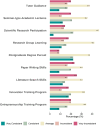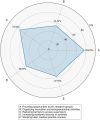Perceptions, attitudes, and barriers to research engagement among general medicine undergraduates in a tertiary hospital in Guangdong, China
- PMID: 40420126
- PMCID: PMC12105211
- DOI: 10.1186/s12909-025-07343-z
Perceptions, attitudes, and barriers to research engagement among general medicine undergraduates in a tertiary hospital in Guangdong, China
Abstract
Background: Research is a critical component of medical education, fostering critical thinking and evidence-based practice. However, in China, particularly in the context of general practice, undergraduate medical students often face significant barriers to engaging in research. This study aims to assess the perception, attitude, and practice toward research among undergraduate medical students in a tertiary hospital in Guangdong, China, and to identify the barriers they face.
Methods: A cross-sectional study was conducted among 90 undergraduate medical students from a tertiary hospital in Guangdong, China, from May to June 2024. A self-administered questionnaire was used to collect data on students' perception, attitudes, practices, and perceived barriers toward research.
Results: The majority of students (46.6%) expressed a strong desire to pursue postgraduate studies, while only 25.5% showed a strong interest in participating in research. Key barriers included lack of time (65.5%), insufficient research guidance (56.6%), and limited access to resources (47.8%). Students' self-assessment of their research abilities was generally low, with only 9.5% feeling confident in their ability to handle data. Positive correlations were found between access to research guidance and interest in scientific literature (r = 0.62, P < 0.001).
Conclusion: This study identifies key areas for improving research training among undergraduate medical students, particularly in general practice programs. It suggests that standardized curricula, enhanced mentorship, and hospital-university research platforms may help address existing gaps. Given the study's limited sample and setting, further research is needed to confirm these findings in broader contexts.
Clinical trial number: Not applicable.
Keywords: Barrier factors; Medical undergraduate medical students; Research attitude; Research perception; Research practice.
© 2025. The Author(s).
Conflict of interest statement
Declarations. Ethics approval and consent to participate: This study adhered to the principles of the Declaration of Helsinki and fully complied with national relevant ethical regulations and standards for medical research involving human subjects. All procedures involving human participants were reviewed and approved by the Ethics Committee of Maoming People’s Hospital, which operates in accordance with the requirements of national laws and regulations. Informed consent was obtained verbally from the student participants after they were fully informed about the study’s objectives, methods, potential risks, and benefits. Throughout the research process, strict confidentiality of participants’ personal information was maintained, and all data were used solely for the purpose of this study to contribute to the development of medical education and healthcare improvement in line with the well-being of the public. Consent for publication: Not applicable. Competing interests: The authors declare no competing interests.
Figures






Similar articles
-
Attitudes toward and perceptions of barriers to research among medical students in the context of an educational and motivational strategy.BMC Med Educ. 2025 Apr 30;25(1):635. doi: 10.1186/s12909-025-07229-0. BMC Med Educ. 2025. PMID: 40307818 Free PMC article.
-
The interplay between research expectations and perceived barriers: a mediation analysis among Chinese medical undergraduates.BMC Med Educ. 2025 Apr 15;25(1):537. doi: 10.1186/s12909-025-07098-7. BMC Med Educ. 2025. PMID: 40234810 Free PMC article.
-
Perception, practice, and barriers toward research among pediatric undergraduates: a cross-sectional questionnaire-based survey.BMC Med Educ. 2024 Apr 3;24(1):364. doi: 10.1186/s12909-024-05361-x. BMC Med Educ. 2024. PMID: 38570767 Free PMC article.
-
The next generation of physician-researchers: undergraduate medical students' and residents' attitudes, challenges, and approaches towards addressing them.BMC Med Educ. 2024 Nov 14;24(1):1313. doi: 10.1186/s12909-024-06166-8. BMC Med Educ. 2024. PMID: 39543546 Free PMC article. Review.
-
A review of literature on medical students and scholarly research: experiences, attitudes, and outcomes.Acad Med. 2015 Aug;90(8):1162-73. doi: 10.1097/ACM.0000000000000702. Acad Med. 2015. PMID: 25853690 Review.
References
-
- Creswell JW, Creswell JD, et al. Research design: qualitative, quantitative, and mixed methods approaches. 5th ed. Sage 2017.
-
- Robinson KA, Brunnhuber K, Ciliska D, Juhl CB, Christensen R, Lund H. Evidence-based research series-paper 1: what evidence-based research is and why is it important? J Clin Epidemiol. 2021;129:151–7. - PubMed
-
- Walport M, Brest P. Sharing research data to improve public health. Lancet. 2011;377(9765):537–9. - PubMed
-
- Hernán MA. Methods of public health research - strengthening causal inference from observational data. N Engl J Med. 2021;385(15):1345–8. - PubMed
MeSH terms
Grants and funding
- LCJX2024065/Teaching Reform Research Project of Clinical Teaching Bases of Guangdong Medical University
- 220420204551816/Science and Technology Fund of Maoming City
- B2025501/Medical Research Fund of Guangdong Province
- zx2020017/High-level Hospital Construction Research Project of Maoming People's Hospital
- ZX2020026/High-level Hospital Construction Research Project of Maoming People's Hospital
- SY2021005/Excellent Young Talents Project of Maoming People's Hospital
- 2021KJZXZJYX003/Special Science and Technology Fund of Maoming City
- 2020KJZX017/Special Science and Technology Fund of Maoming City
- 240524224551088/the Science and Technology Fund of Maoming City
- 2024kjcxLX045/the Science and Technology Fund of Maoming City
- 2021S0028/Guangdong Province Science and Technology Innovation Strategy Special Fund in Maoming City
- SY2021001/Double Dalent Plan of Maoming People's Hospital
- 2022A1515011655/Natural Science Foundation of Guangdong Province
LinkOut - more resources
Full Text Sources

